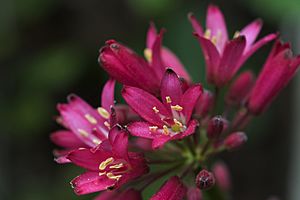Clintonia andrewsiana facts for kids
Quick facts for kids Clintonia andrewsiana |
|
|---|---|
 |
|
| Sonoma County, California (May 2010) | |
| Conservation status | |
| Scientific classification | |
| Genus: |
Clintonia
|
| Species: |
andrewsiana
|
| Synonyms | |
|
|
Clintonia andrewsiana is a type of flowering plant in the lily family, called Liliaceae. This plant was first found by John Milton Bigelow in 1854. Later, John Torrey officially described it in 1856.
The plant's scientific name, andrewsiana, honors Timothy Langdon Andrews. He was a person who carefully studied plants in California in the 1800s. People often call this plant Andrews clintonia or red clintonia. The name "red clintonia" comes from the color of its flowers. In California, it is also known as bluebead lily or western bluebead lily. However, it's important not to mix it up with another plant, C. borealis, which is also called bluebead lily. The Pomo people, who live in northern California, believed this plant was poisonous.
Plant Description
Clintonia andrewsiana is a perennial herbaceous plant. This means it is a plant that lives for more than two years and has soft stems, not woody ones. It spreads using underground stems called rhizomes.
This plant is the largest in its group, growing from about 30 to 80 centimeters (12 to 31 inches) tall. Around the bottom of the plant, there are 5 or 6 oval-shaped, dark green leaves. Each leaf is about 20 to 35 centimeters (8 to 14 inches) long and 5 to 15 centimeters (2 to 6 inches) wide.
The plant has a tall, straight flower stalk, which is called an inflorescence. This stalk holds many flowers. At the very top, there is a group of 10 to 20 flowers shaped like an umbel (like an umbrella). There can also be up to three smaller groups of 2 to 4 flowers along the sides. Each flower has six pink to reddish-purple "petals," which are actually called tepals. These tepals are about 1 to 2 centimeters (0.4 to 0.8 inches) long. Inside the flower, there are six stamens, which are about half as long as the tepals. After the flowers bloom, the plant produces a blue or blue-black berry. These berries are about 1 centimeter (0.4 inches) across.
Where the Plant Grows
Clintonia andrewsiana is found along the West Coast of the United States. It grows from Monterey County in central California up to Curry County in southwestern Oregon. This plant likes to grow in shady, damp areas. It is often found in coastal redwood forests.
This plant's growing area sometimes overlaps with another plant called C. uniflora. This happens in Humboldt County and Del Norte County in northwestern California, and in Curry County, Oregon. However, it's easy to tell the two plants apart by their flowers. C. andrewsiana has many flowers grouped together in umbrella-like shapes. In contrast, C. uniflora has only one flower, and its tepals are white. The tepals of C. andrewsiana are a deep reddish-purple color.
Images for kids




